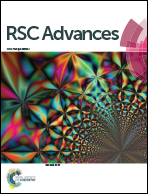Photosensitisation studies of silicone polymer doped with methylene blue and nanogold for antimicrobial applications†
Abstract
Photosensitisation of polymers has important potential clinical applications such as the prevention of catheter-associated urinary tract infections (CAUTIs). Polymers incorporated with methylene blue (MB) and 2 nm gold nanoparticles (AuNPs) are effective in killing bacteria at the surface following low power visible illumination. Studies of medical-grade silicone polymer samples including segments from urinary catheters were carried out to investigate the generation of reactive oxygen species and the involvement of Type 1 and 2 mechanisms. Singlet oxygen was observed using direct phosphorescence detection and hydroxyl radical generation using electron paramagnetic resonance (EPR) spectroscopy; we conclude that both Type 1 and 2 mechanisms can operate with polymeric photosensitisation. Transmission electron microscopy (TEM) directly demonstrated the incorporation of AuNPs at the surface of the silicone. Using silicone doped with MB AuNPs, a ≥3 log10 reduction in the number of viable Staphylococcus epidermidis bacteria was achieved when exposed to low power laser light; prior sterilisation with ethylene oxide (EO) had no influence on efficacy.


 Please wait while we load your content...
Please wait while we load your content...